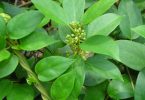Maha shivaratri
Although by Indian traditions, Shivaratri occurs every month, Maha Shivaratri, is the auspicious festival observed on the 14th dark night of Magh (Hindu calendar). It translates to the Great night of Lord Shiva and is when the Lord manifests Himself as the Shivalinga. In Hinduism, Lord Shiva (the destroyer of evil) is one of the three aspects of the divine trinity (Brahman): the creator, Lord Brahma, and the preserver, Lord Vishnu being the other two.
The five syllable holy mantra Namah Shivaya, sung in praise of Lord Shiva, is chanted continually during the night of Maha Shivaratri, along with the Lords other names describing His greatness.
Glory
Lord Shivas glory has been recited throughout the Puranas. His worship in Bharat (India) has been since ancient times, initially in his murti (deity) form, and later as Shivalinga. The Mahabharata relates the story of Maha Shivaratri:
A Bheel (forest inhabitant) named Suswara was out hunting in the forest. To kill was his only means of survival and sustaining his family. One night, having not found anything, he climbed a tree near a lake and sat in despair. He was hungry, thirsty and tired.
To keep himself occupied and to stop himself from falling from the tree, he picked nearby leaves from the tree and dropped them, watching them fall. He cried bitterly for his starving family and sat all night, waiting for the dawn to break.
What Suswara did not realise was the tree was a Bael tree, the tree sacred to devotees of Lord Shiva. Beneath the tree was a Shiva Linga, which he did not know. By not eating and drinking, by washing the Linga with his pure tears, and by offering the Bael leaves to the Linga, he had performed selfless Puja (worship) without even knowing it. The punya (benefit) he had accrued by doing this was so great that at the eventual time of his death, Lord Shiva sent messengers to collect and welcome his soul. His heart had been purified and the Lord shed his mercy on his kind devotee.
Lord Shiva
On Maha Shivaratri, Lord Shiva is worshipped in the form Shivalinga. Lord Shiva has many other forms including:
Shankara the giver of happiness to all
Nataraja – the Lord of Dance (His worshipped form adored by dancers and musicians)
Bholenath- the one who is easily pleased
Pashupati – Lord of creatures (often with Nandi (Bull), His favourite animal)
Mahadeva – the greatest God
When the Ganga River was send to Earth by Lord Vishnu, Lord Shiva was the bearer of the River on his head. Lord Shivas abode peak is believed to be the Kailash Peak in the Himalyas. Lord Shiva is usually depicted as residing there with his consort, Goddess Parvati (the daughter of Himalaya, and deity of strength). They have two sons, Lord Ganesha and Kartikeya.
Ritual
During Mahashivratri, Rudra Sukta (Vedic hymns) is recited by Pandits, whilst bathing Shivalinga with holy waters of the Ganga, known as Rudra-Abhisheka. The flow of the water is said to represent our constant ebb and flow of thoughts, which we surrender to the Lord.
Puja takes place at four different times through the day, and during each stage, a different liquid is used for bathing the Shivalinga. Milk is offered first, followed by curd, Ghee and finally honey. This symbolises our evolution through worshipping the Lord: first we start with the milk, suggesting we are still impure and raw. Upon refining this, we ascend to curd, which is further purified and refined to give ghee. Finally, as our impurities and faults have been removed, we are left with the sweet honey which symbolises the endless joy that emerges from Bhakti (devotion). Bael leaves are also offered, as are flowers, incense and many other items.
In Saurashtra, Gujarat, the town of Junagadh hosts a grand mela where many thousands of saints and sannyasis (renunciates) congregate at the foothills of the mighty Mount Girnar.





